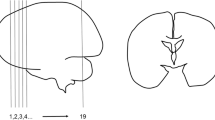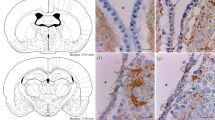Summary
Two different types of ependymal cells were found in the subcommissural organ (SCO) of Natrix maura. Most secretory cells showed morphological features resembling the general structure and ultrastructure of cells in the SCO of other vertebrates. This report describes a second population of cells lining a portion of the dorsal groove of the SCO. These cells were not selectively stained by chromalum-hematoxylin and, under the electron microscope, they were characterized by scarce surface differentiations, sparse apical cytoplasm and short basal processes. Flat, parallel cisternae of the rough endoplasmic reticulum produced vesicles that appeared to be transported to the well-developed Golgi apparatus. Dense secretory granules about 200 nm in diameter were found in the Golgi region. Similar granules were seen in the vicinity of the apical plasma membrane; some of them opened toward the ventricle. All these characteristics clearly differentiate this cell group from the other secretory cells lining the SCO laterally and ventrally.
Similar content being viewed by others
References
Diederen JHB (1970) The subcommissural organ of Rana temporaria L. A cytological, cytochemical, cyto-enzymological and electron-microscopical study. Z Zellforsch 111:379–403
D'Uva V, Ciarcia G (1976) The subcommissural organ of the lizard Lacerta s. sicula Raf. Ultrastructure during winter. Experientia 32:1327–1329
D'Uva V, Ciarcia G, Ciarletta A (1976) The subcommissural organ of the lizard Lacerta s. sicula Raf. Ultrastructure and secretory cycle. J Submicrosc Cytol 8 (2–3):175–191
Leonhardt H (1980) Organum subcommissurale. In: Oksche A (ed) Handbuch der Mikroskopischen Anatomie des Menschen. 4. Band: Nervensystem, 10. Teil: Neuroglia I. Springer, Heidelberg Berlin New York pp 472–504
Murakami M, Okita S, Nagano Y (1970) Electron microscopic observation of the subcommissural organ of the soft shelled turtle Amyda japonica. Arch Histol Jpn 31:199–208
Murakami M, Shimada T, Oribe T, Hiraki T (1972) An electron microscopic study on the subcommissural organ of the monkey Macacus fuscatus. Arch Histol Jpn 34:61–72
Oksche A (1969) The subcommissural organ. J Neurovis Relat 9:111–139
Rodríguez EM (1970) Ependymal specializations II. Ultrastructural aspects of the apical secretion of the toad subcommissural organ. Z Zellforsch 111:15–31
Rodríguez EM Personal communication
Sterba G, Kiessig Chr, Naumann W, Petter H, Kleim I (1982) The secretion of the subcommissural organ. A comparative immunocytochemical investigation. Cell Tissue Res 226 (2):427–441
Ziegels J (1976) The vertebrate subcommissural organ. A structural and functional review. Arch Biol (Bruxelles) 87:429–476
Author information
Authors and Affiliations
Rights and permissions
About this article
Cite this article
Fernández-Llebrez, P., Pérez-Fígares, J.M., Becerra, J. et al. Morphological evidence for the presence of two cell types in the ependyma of the subcommissural organ of the snake, Natrix maura . Cell Tissue Res. 238, 407–409 (1984). https://doi.org/10.1007/BF00217314
Accepted:
Issue Date:
DOI: https://doi.org/10.1007/BF00217314




